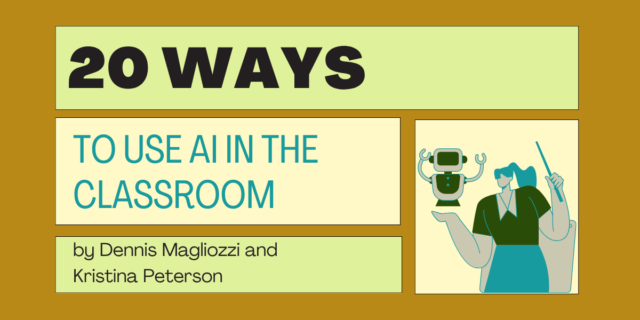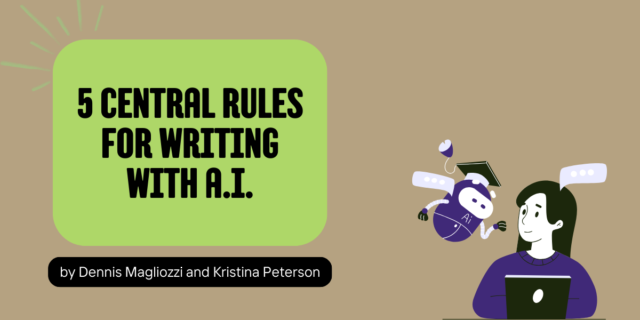
"Showing children that they have changed as community members, learners, readers, and writers reveals that they are in the process of becoming . . . The advantage of drawing attention to change in learning and behavior is that children can project learning futures." -Peter Johnston, Choice Words
In his influential book Choice Words, Peter Johnston explores how certain types of teacher language and questions can nurture positive identities as readers and writers in young people. He argues for helping students notice and name the specific, effective moves they make as writers and readers. “Language,” says Johnston, “actually creates realities and invites identities.” My theory as a writing teacher this past year was this: getting my students to reflect on and talk about the revisions they were trying—to ask them to “get a little ‘meta’”—would help foster these identities and build a culture of revision in my classroom.
I used to think mini-lessons were basically all we needed to revise. In my teacher-centered classroom, I’d model a strategy—trying new leads or slowing down the “hot spot” of a story, for example—have students try it, and move on to the next. I hoped the skills would transfer to my students’ writing, and sometimes they did. But now I see that to internalize these moves, my students need to connect what they’ve learned—the revision strategies posted on the wall—to their own work. A revision move isn’t really theirs until they see it reflected back in their writing. They can’t own it until they recognize and discover it on their own.
So though I sometimes initiate the noticing and naming, I try as much as possible to have it start with student inquiry. It often begins with students reflecting on a piece of writing—their own, their classmate’s, or mentor texts. In the spirit of building a culture of revision, I’m hoping to draw my students’ attention to these revision strategies in the writing around them. With a host of small metacognitive moves, I’m trying to get my students to find and discover the brilliance in their writing and that of their peers.
It’s a month and half into school, and Alyssa shares a story that includes some conflicted (and very funny) thoughts—“inner dialogue”—about getting on an intimidating roller coaster with her dad. Her classmate Jack pipes up, “Alyssa is really good at doing that thing with the two voices in her head! It’s like one side is saying, ‘You’re going to die!’ and the other one is like, ‘You can do it!’” Once my students start noticing and naming the writing moves they see (even if they need some help articulating names for the strategies), they can start to envision how they might try these in other pieces. As Johnston points out, when we notice and name the moves that resonate with us it “makes the hidden . . . skill of the individual into a future resource for the individual and the community.”
Our metacognitive approaches can take many forms:
- Solo reflections. These could be simple and global (“Fist to five: What do you think about the quickwrite you just finished?”) or more specific to a strategy we’ve worked on (“Star your favorite lines of figurative language you wrote today in your journal”). The goal is to use language that invites revision; with their periodic “thoughtshots,” students reflect independently on questions such as “What revision strategies have you already tried to improve this piece?” and “What revision strategy will you try next as a writer?”
- Partner activities. We often use structures such as turn-and-talks to reflect out loud. For example, after researching for a PSA (public service announcement) on an issue related to our local watershed, students might discuss in pairs what facts they could pull into their science script. Talking with a partner lets them reflect aloud on their possible revisions—and hear thoughts from a peer. “Show your partner several of the new titles you brainstormed for your fiction story. See if he/she has a preference or any new ideas after hearing your piece.”
- Small-group work. Table groups give my students more voices to hear from—for instance, if we are sharing a draft and getting feedback. We generally start with the students’ personal and positive responses, then move on to questions we had and “what ifs” or suggestions. Sometimes we begin with students’ discoveries about the moves their favorite authors make. Reading from piles of books in the center of their table, students might find their favorite leads. After five to ten minutes, I ask them to share one with their group and see if they can categorize this lead. “Which leads grabbed you most? How did the author hook you in this way?”
- Whole-class structures. Sometimes we read our writing pieces to the entire class—the classic student-author share—but we play with lots of other large-group reflections as well. In a “migration,” students leave out their writing and then walk around the classroom, reading several of their classmates’ drafts. They might leave Post-it notes with kudos or questions as they migrate around. At the end, we sometimes nominate a fellow student to read aloud some of his or her piece. “What were some of your classmates’ persona poems that really blew you away? Be ready to share after our migration.”
Of course, there’s a caveat in all this explicit noticing and naming: the potential to kill the thing we love by overanalyzing it. Blinding flash: extensive metacognition is not a preferred activity for ten- and eleven-year-olds (or for most elementary and middle school students I’ve taught). Consider a read-aloud where the teacher stops constantly to draw out every possible interpretation, belaboring every teaching point, moving at a glacial pace (student groans and rolled eyes be damned). It’s our job as teachers to be judicious about when to shine a spotlight on the writing moves we see and when to simply stay immersed in the texts and savor them. There’s no formula for this back-and-forth, but it’s important to choose carefully when to emerge from the text and ask kids to be metacognitive. We have to vary our approaches, keep it fresh, engaging, even fun.
So I strive for quick metacognitive bursts during the writing process, not lengthy reflections after the writing is over—a “process present” as opposed to a “process history.”
Regardless of the type of reflection, this noticing and naming usually follows a similar framework:
- “Where in the writing piece did you find yourself pulled in?” I might ask students to star lines they found powerful or that elicited a feeling in them. Perhaps underline sections of an essay they found especially persuasive or lines from a poem that gave them a vivid mental image. At the very least, I want students to be able to identify the places where the writing floored them, even if they can’t articulate why or how.
- “Why did these lines appeal to you?” I will often nudge my students to go beyond just identifying, to consider the effect the words had on them. What emotions did they feel? What pictures did they see? What made these particular lines so good? Did the student writer do anything that reminded you of other texts we’ve read?
- “How did the author do this?” I also try to have my students explore how a particular strategy worked so we can break down its components and reveal how it’s done. “You said the last line of Matt’s book review made you want to read the novel, too. What do you notice about Matt’s ending?” Once it’s clear how Matt used questions—“Will Mark finally make it Mt. Rainier? Will his friend Jess reveal his secret?”—we as writers can try something similar.
- “What can we call this move the writer is making?” If they can, I want my students to name the strategy they’re seeing. “You loved the ending of Matt’s book review of The Honest Truth. What could we call this kind of ending?” If we can give a name to the move we see, it gives it more familiarity—and an invitation to try it ourselves in a future draft.
We’re in a small-group share, and Hannah is reading her memoir, a piece about a frightening accident she witnessed her little sister having. One of her classmates mentions Hannah’s lead, which begins, “She lurched forward, smashing her face into one of the corners of the nightstand. She screamed, blood pouring from her upper lip . . .” Instead of moving on to the next comment, I ask, “Why did you like the lead? What did Hannah do to pull you in as a reader?”
“I could see it happening, and I was wondering who was hurt,” says Cam. Another classmate, Courtney, starts to articulate how Hannah did this. “It was really suspenseful,” remarks Courtney. “She started right in the ‘hot spot’ and grabbed us right away.” As the discussion continues, the students in the group notice how words like “lurched,” “smashing,” and “pouring” really helped give us an image—an unsettling one—and “put us there” as readers. Together, with a little suggesting from me, we name the strategy. “For your lead, you can jump right to one of the most exciting parts of your story, and then just go back in time. Let’s call it a ‘start in the middle of the action’ lead—and Hannah showed it wonderfully . . .”
I’m reminded of some of the best—and worst—coaching I’ve seen (and been on the receiving end of) over the years. I can recall soccer coaches (mostly someone’s dad, with the best of intentions, no doubt) shouting, “Don’t toe the ball!” though I didn’t have the foggiest notion of how to kick it otherwise (Wasn’t my toe at the business end of my foot?). I muddled through, until I had a coach who actually broke down just how to strike a soccer ball effectively. Where you should place your non-kicking foot. The mechanics of pointing the toe of your kicking foot and how it should graze, just so, along the top of the grass so you fire the ball off your laces. Under this coach’s guidance, I started thinking about how I was kicking the ball (instead of just slugging away at it willy-nilly), and I began emulating the different moves he had highlighted. I started going beyond his explicit instructions and began internalizing these actions. The coach’s questions in the huddle (“What are you going to work on in today’s game?”) kept the focus on us to reflect on the skills we had learned and what we should keep working on.
It’s the same when I’m getting “meta” with my young writers. While we can’t—and wouldn’t want to—constantly be thinking about our every move, we do need to reflect periodically in order to grow. Just as my coach sometimes outlined a new skill on his clipboard, I’m adding new revision moves to the Revision Wall in our classroom. His questions before the game are like those I pose to my writers—a way to spark inquiry and shift responsibility for noticing and naming onto them. To have them connect the strategies on the wall to their own work. To remind each player—each writer—that we are “in the process of becoming.” By exploring our own writing process and the revision moves we’re trying, we’re imagining new possibilities and building a culture of revision together.



